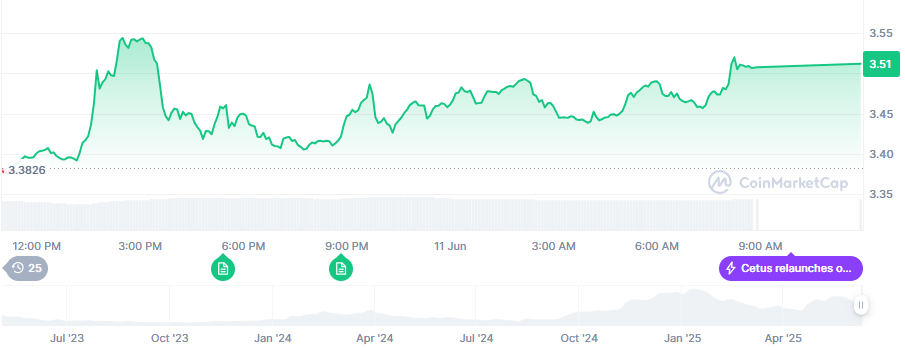As 2025 unfolds with greater clarity in digital asset markets, blockchain participants are increasingly focused on projects that offer either immediate scalability or long-term infrastructure value. Sui (SUI), a Layer 1 protocol known for high throughput and efficient transaction execution, has recently gained traction again—trading at $3.50, with analysts revisiting its 2026 price prediction models. Following its all-time high of $5.35, Sui has captured attention as one of the standout Layer 1 ecosystems aiming to challenge Ethereum’s dominance with speed and flexibility.
But in parallel, Qubetics is making an entirely different play—building a Web3 platform that enables real-world asset tokenization, targeting practical, cross-chain utility instead of raw speed. Its QubeQode IDE has already caught the eye of developers, while the project’s ongoing presale is amassing capital and momentum. The comparison between an established protocol like Sui and a fast-rising project like Qubetics speaks to a broader market trend: finding the next wave of real-world blockchain value, whether that’s through decentralised execution or tokenised economies.
SUI Price Prediction 2026: Growth, Risks, and Outlook
Sui’s approach to scalability, through its parallel transaction execution and support for user-facing decentralized applications—has led many analysts to anticipate a potential breakout in the medium term. The coin is currently stabilizing at $3.50, and its ability to climb back toward or beyond its previous $5.35 ATH depends largely on continued developer adoption and network usage. If Sui maintains momentum, the bullish SUI price prediction for 2026 ranges between $5 and $8, supported by increasing demand for dApps and potential ecosystem expansion across DeFi and NFTs.
However, conservative models temper this enthusiasm, projecting a floor price of around $3.46 if growth remains modest and competition among Layer 1 blockchains intensifies. Even so, this range reflects relative resilience. Analysts also point to the importance of external drivers like institutional interest, exchange listings, and successful onboarding of developers from rival ecosystems. These factors, if executed well, could act as catalysts toward higher valuations.
In short, Sui’s 2026 outlook is bifurcated: it is both a candidate for a strong bull-market rebound and a project that must differentiate itself through meaningful ecosystem traction. With its parallel architecture and rapid execution, Sui is positioned for upward movement—but it needs to validate its long-term use case under competitive market pressure.

Qubetics’ Application: Real World Asset Tokenisation Marketplace and Its Long-Term Implications
While Sui focuses on execution speed and dApp usability, Qubetics is addressing a completely different domain: real-world asset tokenization. Its flagship application—the Real World Asset Tokenisation Marketplace—is designed to enable individuals, businesses, and institutions to digitally represent and trade physical and intangible assets across multiple chains. In practical terms, this means tokenising anything from real estate and equity shares to intellectual property, opening up borderless liquidity while preserving legal verifiability.
The platform’s interoperability-first design means tokenised assets can be transferred across ecosystems, offering functionality that aligns with the future of multi-chain finance. For example, a retail business in Toronto could tokenize part of its receivables and offer liquidity via a blockchain-powered exchange in Singapore—all without needing to onboard separate infrastructure. For governments and banks, Qubetics could pave the way for compliant, real-time tokenisation of treasury instruments, creating deeper and more transparent debt markets.
With the real-world asset tokenization narrative gaining momentum globally, particularly among institutional players, Qubetics’ infrastructure approach represents not just theoretical innovation but a timely response to real market needs. It bridges compliance, transparency, and DeFi accessibility—an area that has been notably underserved by most Layer 1 platforms. That’s what makes it a serious contender, even as more visible chains like Sui command headlines.
Qubetics Presale Momentum: Scarcity, ROI Potential, and Price Trajectory
Qubetics’ current crypto presale metrics signal that the project is already capturing meaningful attention. Now in Stage 37, $TICS is priced at $0.3370, with over 515 million tokens sold and more than $18 million raised. There are just 10 million tokens left at this price point, and over 27,900 participants have already taken early positions. Scarcity is already in play, with Qubetics reducing its total token supply from 4 billion to 1.36 billion, a move that aligns with best practices in economic modeling for long-term valuation.
From a returns standpoint, Qubetics has delivered early gains, and the projections remain favorable. A $6,000 allocation now secures approximately 17,802 $TICS tokens. Should $TICS reach $1, that investment scales to $17,802, representing a 197% return. If it climbs to $5 or $10 within a bullish market cycle, the value jumps to $89,010 or $178,020, respectively. These estimates are grounded in the token’s reduced supply, high demand, and real-world application layer—factors that differentiate Qubetics from more speculative presales.
Smaller entries also show strategic value. A $100 investment today secures 296 tokens. If Qubetics executes its roadmap and listing forecasts play out, that small capital outlay could become a compelling long-tail asset. As the best crypto pre sale continues to accelerate toward its cap, early participants are positioning themselves at a rare intersection of utility and scarcity—one that could make Qubetics a future industry mainstay.
The Bottom Line: Two Strong Narratives, One Converging Trend
The comparison between Sui and Qubetics isn’t about choosing one over the other—it’s about understanding where the next cycle’s value may emerge. SUI’s price prediction for 2026 offers a window into its growth potential if the network sustains ecosystem expansion and dApp development. With a target range of $5 to $8, it continues to look attractive for those who believe in the Layer 1 narrative, especially if parallel execution proves scalable under load.
Yet, Qubetics presents a different kind of promise. As traditional and decentralized finance begin to overlap more tangibly, its Real World Asset Tokenisation Marketplace and tools like QubeQode IDE set it apart as a platform built for infrastructure, not just hype. With a successful presale, credible tokenomics, and utility-focused development, Qubetics may not just mirror success—it may redefine where blockchain value accrues next.
For More Information:
Qubetics: https://qubetics.com
Presale: https://buy.qubetics.com/
Twitter: https://x.com/qubetics
Press releases or guest posts published by Crypto Economy have been submitted by companies or their representatives. Crypto Economy is not part of any of these agencies, projects or platforms. At Crypto Economy we do not give investment advice, if you are going to invest in any of the promoted projects you should do your own research.








